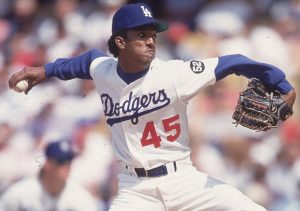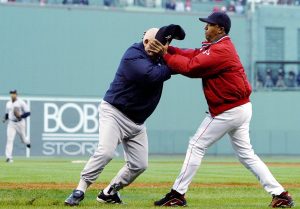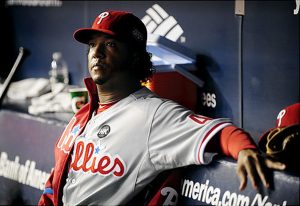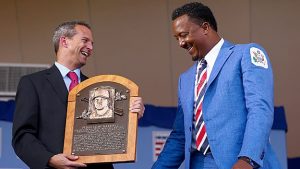Pedro Martinez is a hall of fame pitcher and arguably the best right handed pitcher to ever take the mound. We all remember his glory days in Boston where he had the single highest peak by a starting pitcher ever. But today we are going to start out at the beginning. From the days where people thought he couldn’t make it as a starting pitcher because of his small stature and frame, all the way up to his induction to the hall of fame, enjoy this player spotlight.
Los Angeles Dodgers: Early Years As A Reliever
Pedro made his MLB debut on September 24, 1992 for the Dodgers against the Cincinnati Reds, working two scoreless innings of relief. He made his first start for the Dodgers on September 30, taking the loss while giving up two runs in a 3–1 loss to the Reds.
Being a starter is what Pedro always envisioned being, but that wouldn’t be his role with the Dodgers. Dodgers Hall of Fame Manager Tommy Lasorda viewed Martinez as too small to be an effective starting pitcher at the MLB level. Thus Lasorda used Pedro Martínez almost exclusively as a relief pitcher.
Questioning Martinez ability to be a starter wasn’t a new narrative. In the minor leagues, the then-135-pound Martinez was threatened with a $500 fine if he was caught running. They wanted him to bulk up to withstand the marathon that is being a starting pitching.
In 1993, Martinez thrived as the Dodgers set-up man. He posted a 10–5 record with a 2.61 ERA and 119 strikeouts, in 65 games. He also led all NL relievers with 107 innings pitched. However his tenure in Los Angeles would come to an end in the offseason.
With the Dodgers in desperate need for a second baseman, they traded Martinez to the Montreal Expos for Delino DeShields in the winter of 1994.
Montreal Expos: Developed into a Top Tier Starting Pitcher
When Martinez arrived in Montreal, his fastball was one of the most electrifying pitches in the game, but there was an issue. Martinez struggled to consistently command the pitch, something he would have to correct if he were to become a starting pitcher.
During a bullpen session, manager Felipe Alou encouraged him to modify his grip on the fastball from two fingers to four. The slight modification altered the path of Martinez’s career. He instantly gained pin-point control of his 100 MPH fastball, making it one of the toughest pitches to hit.
On April 13, 1994, Martínez took a perfect game through 71⁄3 innings until throwing a pitch that almost hit batter Reggie Sanders. Sanders immediately charged the mound, starting a bench-clearing brawl, and ending Martinez’s perfect game bid.
He capped of his first season in Montreal with a 11-5 record with a 3.42 ERA. A very solid and promising season for his first full time chance as a starting pitcher.
1995 Season
1995 was another growth season for Martinez. By starting 30 games Martinez upped his innings pitched by 50. He finished the season with a 14-10n record with a 3.51 ERA.
One of the most unique feats in the sports history occurred on June 3, 1995. Martinez pitched nine perfect innings in a game against the San Diego Padres. However he is not credited with pitching a perfect game. The game was tied and went to extra innings. The Padres got a hit of Martinez in the 10th, ending the perfect game.
1996 Season: 1st All-Star Appearance
The 1996 season was a year of first for Martinez. Martinez was selected to his first All-Star team, and began to show signs of his potential dominance. He eclipsed the 200 strikeout mark for the first time.
There was another first for Martinez this season, and it wasn’t statistical. During a game against the Philadelphia Phillies, opposing pitcher Mike Williams threw consecutive pitches at Martinez. After the second failed attempt, Martinez charged the mound and started a brawl. Usually it is Martinez getting charged at, but with him getting a taste of his own medicine, he retailed like hitters do to him.
1997 Season: NL Cy Young Award Winner
In 1997, Martínez posted a 17–8 record for the Expos, and led the league in half a dozen pitching categories. These categories include a 1.90 ERA, 305 strikeouts and 13 complete games pitched. Martínez was the first right-handed pitcher to reach 300 strikeouts with an ERA under 2.00 since Walter Johnson in 1912.
This dramatic step into the elite tier of pitching didn’t go unnoticed by voters as he was won his first NL Cy Young Award. This Cy Young season would also be his final season Montreal.
Boston Red Sox (1998-2004): Pinnacle of Martinez’s Career

Approaching free agency, Martínez was traded to the Boston Red Sox in November 1997 for Carl Pavano and Tony Armas, Jr. Soon after he signed a six-year $75 million contract with the Red Sox.
Martinez began paying dividends immediately as he proved he could pitch in the tougher American League. In 1998 Martinez posted a 19–7 record, and finishing second in the American League in ERA, WHIP, and strikeouts. Unfortunately for Martinez, he also finished second in the AL Cy Young voting.
1999 Season: The Triple Crown
1999 Pedro Martinez will go down as arguably the best pitching season in the history of the sport. Martínez finished the season with a 23–4 record, a 2.07 ERA and 313 strikeouts, winning the pitchers triple crown. He led the entire major leagues with K/9 and K/BB ratios of 13.20 and 8.46. His Fielding Independent Pitching (FIP) of 1.39 was the lowest in modern major league history. In comparison, the next best FIP that season was Randy Johnson who had a 2.76.
This earned Martinez a unanimous AL Cy Young Award. Maybe evermore impressive was that Martinez finished 2nd in MVP voting, something extremely rare for pitchers.
In fact Martinez actually had the most first place votes and should have won the MVP, but two writers left him off their ballot for no reason. As a result he didn’t receive enough total votes, leaving the rest of the writers confused.
To further understand Martinez’s dominant season, take a look at his strikeouts. The 313 for the season is already impressive, but it gets even more so when you look at stretches throughout the season.
Between August 1999 and April 2000, Martínez had ten consecutive starts with 10 or more strikeouts. Only three pitchers have had as many as seven such starts in a row. He averaged more than 15 strikeouts per nine innings during his record 10-game streak. During the 1999 season, he set the record for most consecutive innings pitched with a strikeout, with 40. For his career, Martínez has compiled 15 or more strikeouts in a game ten times, which is tied the third-most 15-K games in history.
Maybe the single most impressive all star game moment in modern baseball was with Martinez on the mound at Fenway Park. He struck out Barry Larkin, Larry Walker, Sammy Sosa, Mark McGwire and Jeff Bagwell in two innings. It was the first time any pitcher struck out the side to start an All-Star Game, and the performance earned Martínez the All-Star Game MVP award.
1999 Playoffs
Martínez was a focal point of the 1999 playoffs for the Red Sox. But after injuring his back in Game 1 of the ALDS, things were in question. Unable to start the decisive Game 5, Martinez was in the bullpen and unexpected to take the mound. Martínez entered the game as an emergency relief option. Martínez somehow neutralized the Cleveland lineup with six no-hit innings for the win, despite not having command of either of his two best pitches.
Martinez would take the ball in Game 3 of the American League Championship Series, against the rival New York Yankees. He pitched seven shutout innings out dueling Roger Clemens and the New York Yankees. However it would be the only game the Yankees lost in the entire playoffs and the Red Sox went home in 5 games.
2000 Season: Better than 1999?
People have argued for years about which incarnation of Pedro was better, ’99 Pedro or 2000 Pedro. Truth be told, I don’t have the answer. I’ll present the stats and let you decide for yourself.
Martínez posted an exceptional 1.74 ERA, the AL’s lowest since 1978, while winning his third Cy Young Award. His ERA was about a third of the park-adjusted league ERA of 4.97. The next lowest AL ERA was 3.70 by Roger Clemens, a whole 2 runs more than Pedro’s.
His record for the season was 18-6, down from his 23-4 in 1999. But truth be told, he could have won 6 more games. In his six losses, Martínez had 60 strikeouts, 8 walks, and 30 hits allowed in 48 innings, with a 2.44 ERA and an 0.79 WHIP, while averaging 8 innings per start. Martínez’s ERA in his losing games was less than the leading ERA total in the lower-scoring National League (Kevin Brown’s 2.58). It is crazy to think he took the loss in each off those games.
Two of the losses came agaisnt the Yankees. Both games Andy Pettitte out dueled Martinez. The most memorable was when the Yankees beat Martinez 1-0. In that game Martinez pitched a complete game, striking out 17 and allowing just one walk.
Martínez’s WHIP in 2000 was 0.74, breaking the previous 0.77 MLB record posted in 1882. Opposing hitters had very minuscule success of Martinez. Batters hit .167 with a .213 on-base percentage, setting two more modern era records.
Martínez became the only starting pitcher in history to have more than twice as many strikeouts in a season (284) as hits allowed (128).
In the span of 1999 and 2000, Martínez allowed 288 hits and 69 walks in 430 innings, with 597 strikeouts, an 0.83 WHIP, and a 1.90 ERA. Baseball historians believe this performance represents the peak for any pitcher in baseball history.
2001 Season: Injury Shortened Season
Martínez spent much of 2001 on the disabled list with a rotator cuff injury. But while on the field Martinez was still dominant. Not quite the levels of 99 and 2000, but still impressive. Martínez finished with a 7–3 record, a 2.39 ERA, and 163 strikeouts, but only threw 116 innings.
2002 Season: Robbed of the AL Cy Young
Back in good health for the 2002 season, Martinez was back to being dominant. He lead the league with a 2.26 ERA, 0.923 WHIP and 239 strikeouts. Finishing the season 20-4, Martinez should have won the Cy Young Award right? Well he didn’t.
The Cy Young Award narrowly went to 23-game winner Barry Zito of the Oakland A’s, despite Zito’s higher ERA, higher WHIP, fewer strikeouts, and lower winning percentage. Martínez became the first pitcher since the introduction of the Cy Young Award to lead his league in each of those four statistics, yet not win the award.
2003 Season: Only Regret of His Career
For the fifth time, Martinez led the league in ERA (2.22) and WHIP (1.04). Combined with his 14-4 record and 206 strikeouts, Martinez finished 3rd in Cy Young voting.
The real memory around Pedro and the 2003 season is his battles with the Yankees in the ALCS. It was a classic series at the peak of the rivalry. In the testy Game 3 of the 2003 ALCS, after allowing single runs in the 2nd, 3rd, and 4th innings, Martínez hit Yankees right fielder Karim García near the shoulders with a pitch, sparking a shouting match between Martínez and the New York bench.
Emotions remained high in the bottom of the inning, which was led off by Boston slugger Manny Ramírez. Ramírez became irate over a high pitch from Roger Clemens, and both benches cleared. During this brawl, the single lowest point of Martinez’s career took place.
72-year-old Yankees Bench Coach Don Zimmer ran on to the field and headed straight for Martínez. As he approached, Martínez grabbed Zimmer, throwing him to the ground.
Martínez wrote in 2015 that the altercation with Zimmer was his only regret of his entire career.
2004 Season: World Series Champions
Martínez went 16–9 in 2004, despite an unusually high 3.90 ERA. Once again making it to the ALCS vs the rival Yankees, the Red Sox found themselves down 0-3 in the series. But then the Red Sox made history, becoming the only MLB team to ever come back and win a series after being down 3-0.
Martinez lost Game 2 of the series, but started Game 5, a game that really turned the tide for the series. He wasnt spectacular, but he kept the Yankees in check and the Red Sox in the game.
Martinez took the ball in Game 3 of the Word Series against St. Louis. He pitched 7 scoreless innings, giving up just 3 hits. The next night the Red Sox closed out the Cardinals, winning their first title in 86 years.
New York Mets (2005-2008)
After being apart of Boston’s World Series triumph in 2004, Martínez became a free agent and signed a 4-year $53 million contract with the New York Mets.
In 2005, his first season as a Met, Martínez posted a 15–8 record with a 2.82 ERA, 208 strikeouts, and a league-leading 0.95 WHIP. While not peak Pedro from his days with Boston, he was still a top tier pitcher.
Martínez started the 2006 season at the top of his game. At the end of May, he was 5–1 with a 2.50 ERA, with 88 strikeouts and 17 walks and 44 hits allowed in 76 innings. However he would injure himself, slipping in the dugout. Missing time with an injured hip, Martinez’s promising season was derailed beginning on June 6.
Martínez went 4–7 with a 7.10 ERA in a series of spotty starts interrupted twice by stays on the disabled list. A right calf injury plagued him for the last two months of the season. television cameras found him in the Mets dugout, apparently crying. MRI tests revealed a torn muscle in Martínez’s left calf, and a torn rotator cuff. Martínez underwent surgery which sidelined him for most of the 2007 season.
Martinez did return in late 2007, pitching in 5 games. He was actually really good and it gave hope that 2008 could be a promising bounce back season. But that wouldn’t come to be.
He was injured just four innings into his first game of the season when he felt a pop in his hamstring. He was diagnosed with a strained hamstring that sidelined him for two months. Upon his return, Martinez was not his old self. Martínez finished the season on a low note, losing all three of his decisions in September en route to a 5–6 record. This was the first losing record of his career. Martinez’s 5.61 ERA and 1.57 WHIP were also his worst ever.
Philadelphia Phillies (2009)
A free agent, Martínez did not sign with a major league team during the winter. In March, he joined the Dominican Republic’s team for the 2009 World Baseball Classic, in an attempt to showcase his arm. Surprising to many, Pedro was quite good. He pitched six scoreless innings with 6 strikeouts and no walks, but no teams came to him with an offer.
In July 2009, the Phillies gave Martinez a workout and he made the team. On August 12th, Martinez would find his place in the rotation and win his first start back. Philadelphia won each of Martínez’s first seven starts, earning his trust to pitch in the postseason.
In the NLCS against the Los Angeles Dodgers, he pitched seven shutout innings while allowing just two hits. His next postseason start would come in a familiar place, Yankee Stadium.
Pedro was set to start Game 2 of the World Series at Yankee Stadium and the New York press was all over him. With all the attention, Martinez seemed right at home.
“When you have 60,000 people chanting your name, waiting for you to throw the ball, you have to consider yourself someone special, someone that really has a purpose out there.”- Martinez prior to the Game 2 start
Martínez was effective in his second-ever World Series start, but left the game in the 7th inning trailing, 2–1, and wound up taking the loss. But he would get another chance to take the ball in Game 6.
Before his second start of the Series, Martínez called himself and opposing pitcher Andy Pettitte “old goats.” It was fitting that this was the final start of his career, facing the Yankees and Pettitte, two long time foes.
Martínez allowed 4 runs in 4 innings, as the Phillies lost the sixth game and the 2009 World Series to the New York Yankees.
Retirement And the Hall of Fame
Martinez had no intentions of retiring after the 2009 season, but the winter came and went with no teams offering him a deal. The Phillies had discussions with bringing Martinez back again but they never progressed. On December 4, 2011, he officially announced his retirement.
Martínez was elected to the National Baseball Hall of Fame in January 2015 with 91.1% of the vote. His Hall of Fame plaque has him wearing a Boston Red Sox cap.
In case you missed it:





